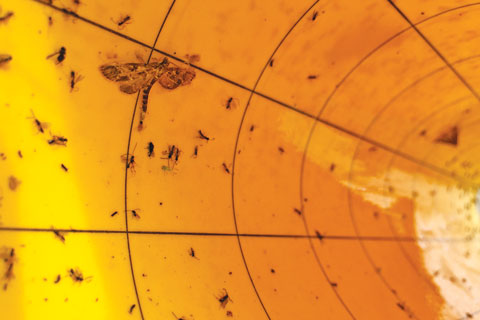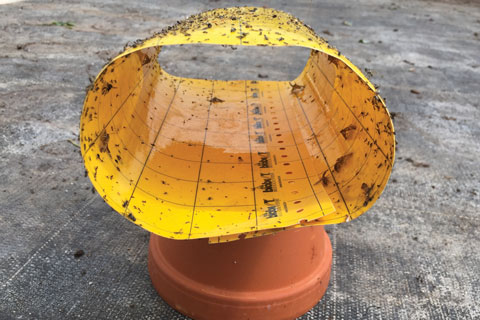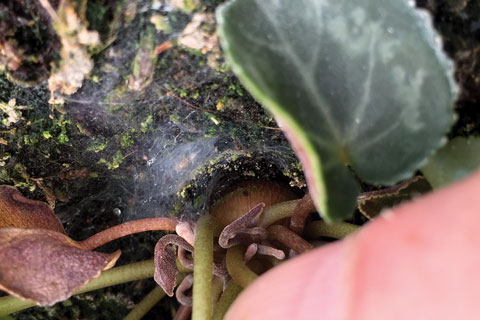2/1/2021
Shifty ’pillars
Jennifer Zurko
When it comes to greenhouse pests, we tend to focus on the most-common ones, like aphids, thrips and whiteflies. But other types whose life stages include caterpillars have been getting more attention during the last few years.
 One of those is the European pepper moth (Duponchelia fovealis), which experts and researchers are saying are becoming more prevalent and widespread in greenhouse crops in Western Europe and North America. We’ve included information about the European pepper moth in these pages before, including in a column in 2017 by Paul Westervelt of Saunders Bros., who called it “the sneaky little moth that tried to eat us out of house and home.”
One of those is the European pepper moth (Duponchelia fovealis), which experts and researchers are saying are becoming more prevalent and widespread in greenhouse crops in Western Europe and North America. We’ve included information about the European pepper moth in these pages before, including in a column in 2017 by Paul Westervelt of Saunders Bros., who called it “the sneaky little moth that tried to eat us out of house and home.”
Figure 1. Close up of a European pepper moth (Duponchelia fovealis) on a yellow sticky trap.
This past fall, Biobest released a warning about the European pepper moth. I wanted to get a few more details on why growers should be on the lookout for this pest, so I asked Simon Foster, IPM & Pollinator Specialist for Biobest, to answer a few questions.
GrowerTalks: Do you know why the European pepper moth has become more widespread in greenhouse crops in recent years?
Simon Foster: Duponchelia fovealis is native to southern Europe and the Mediterranean basin. In more northerly latitudes, it’s restricted to glasshouse crops.
It arrived in California in 2004, and in the following years, particularly from 2010 onwards, it spread more widely around the U.S. and is quite likely to become established in certain parts of the U.S. in areas with a similar climate and habitats to its native range—areas such as the West Coast and Southeastern U.S.
It is largely due to the international trade in plant material that has seen the spread of Duponchelia. In California in 2004, for example, it was in a shipment of begonias. Commercial plant materials—such as fresh fruit and vegetables, as well as cut flowers and cuttings—can harbor larvae, which are able to bore into the stems or remain well-hidden in the foliage.
GT: I know it’s the caterpillar stage that’s the most damaging and that it feeds on a wide range of plants, especially kalanchoe, begonia and cyclamen—does it tend to feed on more potted flowering plants than bedding ornamentals? Any perennials, shrubs?
SF: Duponchelia causes damage to a wide range of commercial plants, including peppers and other members of the Solanaceae family, such as tomatoes. It can also be a pest in cucumbers, strawberries, blackberries, peanuts, beets, corn, and various herbs, such as basil and marjoram.
In the ornamentals sector, particular favorites of Duponchelia, in addition to the ones you’ve mentioned, include lisianthus, poinsettia and a wide range of aquatic plants. It also feeds on some larger woody plant genera such as ficus and pomegranate.
GT: Because the caterpillars are the most damaging stage, aren’t they easier to detect during scouting?
 SF: Caterpillars are fairly easy to detect on the plants or on the surface of the growing medium where they produce a tell-tale webbing trail as they mature. However, Duponchelia larvae like thick foliage and are reported to be uncomfortable in direct light, preferring darker places, which makes them more difficult to scout. Therefore, it is most effective to monitor the adult moths by using traps with species-specific pheromones.
SF: Caterpillars are fairly easy to detect on the plants or on the surface of the growing medium where they produce a tell-tale webbing trail as they mature. However, Duponchelia larvae like thick foliage and are reported to be uncomfortable in direct light, preferring darker places, which makes them more difficult to scout. Therefore, it is most effective to monitor the adult moths by using traps with species-specific pheromones.
Figure 2. A rolled up yellow sticky trap works well to monitor Duponchelia populations.
GT: If you see leaf and stem damage, is it too late for biological control measures?
SF: Successful biocontrol usually depends upon prevention rather than a curative approach, but you can bring in the fire brigade to deal with an existing Duponchelia problem using higher rates of biocontrols and certain other strategies. Ideally though, this is not a place you want to be, and that is why Biobest works with growers providing high levels of technical support with the biocontrol products to achieve a successful preventative outcome.
GT: Biobest recommends various biologicals to control and eliminate these caterpillars—how do beneficial nematodes help with control? How do you release them?
SF: The mode of action of nematodes as a biocontrol organism is fascinating. Nematodes carry with them a colony of bacteria with which they have a symbiotic relationship. The nematodes enter the Duponchelia larvae through a natural bodily opening and deposit their load of bacteria into the host. These bacteria cause the death of the host by overcoming the host’s immune system, resulting in a severe and irreversible infection that makes the body of the host dissolve, becoming a bacterial soup in which the nematodes produce the next generation of infective juveniles.
To control Duponchelia, nematodes are generally applied in a water suspension, which is drenched onto the surface of the growing medium, either by hand or through the irrigation system. Nematodes are an effective and relatively easy product to use, but because nematodes are a live product, there are certain techniques and methods that your Biobest advisor will provide to ensure maximum efficacy.
GT: How do predatory mites and rove beetles help with control and how do you release them?
SF: The soil-dwelling predatory mite Hypoaspis miles (now known as Strateolaelaps scimitus) is a predator of Duponchelia larvae and eggs, as well as other soil pests, including fungus gnats and thrips pupae. Hypoaspis has the extraordinary ability to survive many weeks without food and it is therefore an excellent tool in a preventative strategy.
The mites are supplied in a peat-based breeding culture. The material containing the mites is spread over the growing medium at an early stage in the crop and the predators quickly establish a population. Often, just one release of Hypoaspis per crop is sufficient to establish a strong population of this beneficial army.
Rove beetles, the best known of which is Atheta (Dalotia coriaria), are supplied in a similar breeding culture. Atheta are applied in a similar way to Hypoaspis.
In the literature, there are some observations of negative interactions (intra-guild predation) between Hypoapsis by Atheta. It is true that Atheta is a pretty robust and aggressive predator. However, it tends to inhabit different spatial environs within the crop and prefers more damp areas, such as under the benches and in damp corners of the greenhouse. It is in these places where the background populations of pests often lurk, so in practice, intra-guild considerations between Hypoaspis and Atheta are not relevant in a crop setting.
GT: When is the best time to use these beneficials?
 SF: The best time to introduce the predatory mite Hypoaspis and the predatory beetle Atheta is close to the start of the crop with the objective of establishing a population. At this time, we also treat a number of different crops with Asperello, which contains the beneficial fungi Trichoderma asperellum. The objective here is to build a strong, healthy plant that can resist the pest and disease attacks. Note that Duponchelia can also create entry points for fungal pathogens.
SF: The best time to introduce the predatory mite Hypoaspis and the predatory beetle Atheta is close to the start of the crop with the objective of establishing a population. At this time, we also treat a number of different crops with Asperello, which contains the beneficial fungi Trichoderma asperellum. The objective here is to build a strong, healthy plant that can resist the pest and disease attacks. Note that Duponchelia can also create entry points for fungal pathogens.
Figure 3. Duponchelia pupae in cyclamen.
Delta traps containing the Duponchelia pheromone are placed in the crop to monitor for an influx of Duponchelia adults, and many growers with a history of problems with Duponchelia and with sensitive crops use preventative treatments of the nematode carpocapsae system.
Based on scouting and monitoring of the Delta traps, the nematode applications can be increased (rate and frequency), and if necessary, more predators can be introduced. But the overall objective is to have a standing army of beneficial organisms and your eyes wide open aided by the Delta traps before the pest causes damage.
GT: What are Delta traps?
SF: A Delta trap is a house-shaped trap particularly suited to monitoring Duponchelia adults. It is constructed of three pieces of plastic sheet forming a triangular prism into which is placed a pheromone bait to attract adult males of the target species onto an adhesive plate or sticky trap, enabling monitoring of moth populations. However we have seen a lot of success using a rolled-up yellow sticky trap.
GT: Does Biobest sell these Delta traps and the pheromones that go with them?
SF: Biobest does indeed sell Delta traps, yellow sticky traps and species-specific pheromones for Duponchelia. Contact your local Biobest representative for details of the product and also tailor-made advice on how to manage this and other pests.
GT: Anything else to note about European pepper moths?
SF: Duponchelia are the insect equivalent of a dumpster in that they feed on a wide range of materials both living and dead, including crop plants, rotting leaves and even potting soil. Interestingly for vegetable growers they rarely feed on the fruit. GT